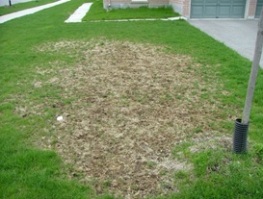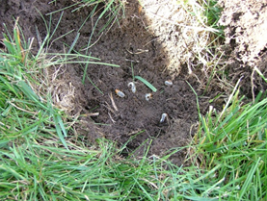As we gear up for the upcoming fall season (yes, it really is on its way!), we’re joined by Jake Lane, our newest guest blogger from LawnStarter.com. Jake has stopped by with a few helpful lawn care reminders as we move past the dog days of summer and begin transitioning into a new season.
With back to school shopping and the new school year fast approaching, most people’s schedules are about to get quite a bit busier. Busy schedules means less time for lawn care tasks, but the good news is, those hot summer days won’t be baking your lawn for too much longer. To help you prepare for the fall season, we laid out some lawn care tips and reminders that will help you keep your lawn lush and healthy into the winter.
1. Deal with Summer Pests
Summertime weather brings out quite a few pests that can wreak havoc on your lawn’s health and appearance. Sometimes the damage can’t be seen until it’s too late. Below are a couple frequent trouble makers that can make lawn care a chore throughout the summer and fall months.
Southern Chinch Bugs
Southern chinch bugs are a nuisance for southern yards, primarily targeting St. Augustine turf. The small bugs suck the juices out of the grass blades and cause damage that resembles drought stress. According to a study done by the University of Florida, chinch bugs cause millions of dollars worth of damage every year. Management and prevention typically entails a mixture of fertilization, mowing, irrigation, and pest control.
White Grubs
Late summer is when white grubs begin showing signs of life, which means the potential for a damaged lawn. White grubs are c-shaped larvae that live below the soil and feed on the roots of your lawn. Grub eggs are laid in late June or early July and the larvae begin to hatch towards the end of July. The grubs can create brown dead spots in your yard and a spongy-like feeling when walking over an area that’s been damaged. It’s best to lay down grub control during the summer to help keep grubs at bay and leave animals that feed on the larvae from digging up and damaging areas of your yard.
2. Don’t Forget the Fertilizer
Labor Day weekend will sneak up on us before we know it, so you’ll probably want to make sure that your lawn is healthy enough to withstand all the holiday foot traffic. Summer time is especially hard on your lawn, so proper fertilization is the key to having a lawn worthy of showing off. It’s recommended that you fertilize your lawn multiple times a year to help combat damage from foot traffic, heat, and other stresses.
If you’ve been lax about applying treatments to your lawn, it’s not too late to start. Hot summer days means that your lawn needs the most nutrients possible to thrive and should bounce back with a little extra work.
3. Water Longer and Less Frequently
The summer heat has been pelting your lawn for a couple of months now and you may need to help resurrect some life into the grass and soil. It’s best to set up a watering schedule that allows water to soak as deep as possible into your soil. It’s better to water thoroughly a couple times a week versus a light spray everyday. This will ensure that your lawn gets the moisture it needs and that you don’t lose very much water to evaporation. Moist soil helps promote long root systems and healthy grass that can take on more stress.
4. Mow Regularly
Ensure that your mower’s blade height is set to a high setting for optimal lawn health. During the hotter months, you only want to cut off one-third of your lawn’s grass blade height. This helps keep soil cool and allows for less moisture to evaporate throughout the day.
Also, make sure that you are mulching your grass clippings, not bagging them. Mulching the grass helps provide nutrients and moisture control for your lawn, all while providing a protective layer on top of soil to help reduce surface temperatures and promote better growth.
5. Aerate
With all the foot traffic your lawn saw this summer, the soil is probably a bit compacted. In that case, you’ll want to aerate your lawn and loosen up your soil to let everything breathe. When you aerate your lawn, you’re allowing both air and water to penetrate the soil easily, helping to boost lawn health. A lot of people aren’t aware of how crucial lawn aeration is for lawn health and maintenance. For the best results, aerate your lawn either in the early spring or fall for cool season grass and mid to late spring for warm season grass.
Having a healthy lawn doesn’t need to take a lot of time or work. Keeping up with routine lawn maintenance can mean less work throughout the year, and help prevent costly repairs. If you need help figuring out what the next best steps are for your lawn, contact your local lawn care professional for assistance.
If you have any questions about your lawn, Weed Man would be happy to help. Find your local office using our locator map HERE.



